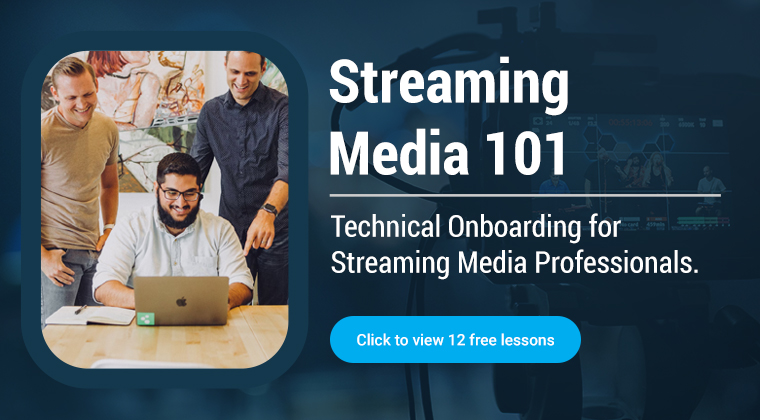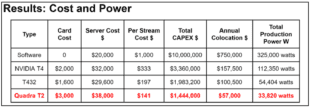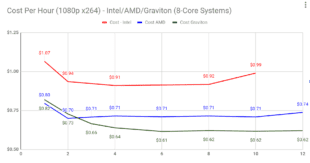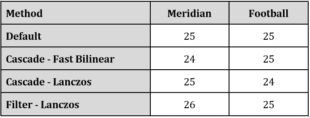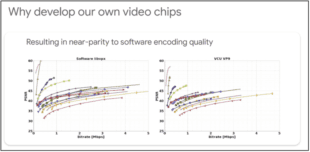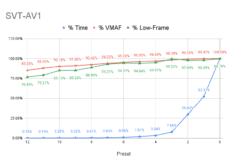My typical workflow for testing-related articles and reports is to create the command string, run the tests, analyze the results, and then write or create the presentation. Since encoding is often so time-consuming, and I’m always in a hurry, I tend to quickly create the command strings with minimal thought, then run the tests, analyze the results, and start to …
Read More »Search Results for: x265
Understanding the Economics of Transcoding
Whether your business model is FAST or subscription-based premium content, your success depends upon your ability to deliver a high-quality viewing experience while relentlessly reducing costs. Transcoding is one of the most expensive production-related costs and the ultimate determinant of video quality, so obviously plays a huge role on both sides of this equation. This article identifies the most relevant …
Read More »The Impact of GOP Size on Video Quality
This freely downloadable report measures the qualitative impact of GOP sizes on animated, general entertainment, sports, and office footage for H.264 and HEVC. One of the most fundamental encoding decisions is GOP size or the frequency of I-frames in our encoded files. I-frames, also called keyframes, start each “group of pictures” comprised of I-, B-, and P-frames. Most of the …
Read More »B-Frames, Ultra Low-Latency Encoding, and Parking Lot Rules
One of my sweetest memories of bringing up our two daughters was weekly trips to the grocery store. Each got a $5.00 bribe for accompanying their father, which they happily invested in various tchotchkes that seldom lasted the week. When we exited the car, “parking lot rules” always applied, which meant that each daughter held one of Daddy’s hands for …
Read More »Which is the Best AWS CPU for FFmpeg?
If you encode with FFmpeg on AWS, you probably know that you have three CPU options: AMD, Graviton, and Intel. Which is the best AWS CPU for FFmpeg? This article reveals all. For those in a hurry, it’s Graviton for x264 and AMD for x265, often by a significant margin. But the devil is always in the details, and if …
Read More »Encoding Ladder: Choosing the Best Codec for Streaming Video
This is the first in a series of posts detailing what you need to know to create the perfect encoding ladder. It’s a high-level introductory series good for streaming novices, but too basic for most experienced streaming producers. This article details how to choose the best codec for streaming video. What’s a codec? A compression technology that shrinks your video …
Read More »Maximizing Quality and Throughput in FFmpeg Scaling
The thing about FFmpeg is that there are almost always multiple ways to accomplish the same basic function. In this post, we look at four approaches to scaling. We found that if you’re scaling using the default -s function (-s 1280×720), you’re leaving a bit of quality on the table as compared to other methods. How much depends upon the …
Read More »How to Build an Encoding Ladder: What You Need to Know
Learning how to build an encoding ladder is one of the most fundamental tasks for a streaming media professional. It’s astounding how much you need to know to get it right. By way of background, the original encoding ladder used by most professionals was from Apple Tech Note TN2224, long since replaced by Apple’s HLS Authoring Specifications. This H.264-only ladder …
Read More »Key Lessons from YouTube’s ARGOS Encoding ASIC
Even in 2023, many high-volume streaming producers continue to rely on software-based transcoding, despite the clear CAPEX, OPEX, and environmental benefits of ASIC-based transcoding. At least part of this inertia relates to outdated concerns about the shortcomings of ASICs, including sub-par quality and lack of upgradeability. As a parent, I long ago concluded that there were no words that could …
Read More »SVT-AV1 vs. LibAOM
In August 2020, the Alliance for Open Media created a software working group to “use the Scalable Video Technology for AV1 (SVT-AV1) encoder developed by Intel…to create AV1 encoder implementations that deliver excellent video compression across applications in ways that remove computational complexity trade-offs for an ever-growing video delivery marketplace.” Testing published around that time indicated that SVT-AV1 had quite …
Read More » Streaming Learning Center Where Streaming Professionals Learn to Excel
Streaming Learning Center Where Streaming Professionals Learn to Excel

